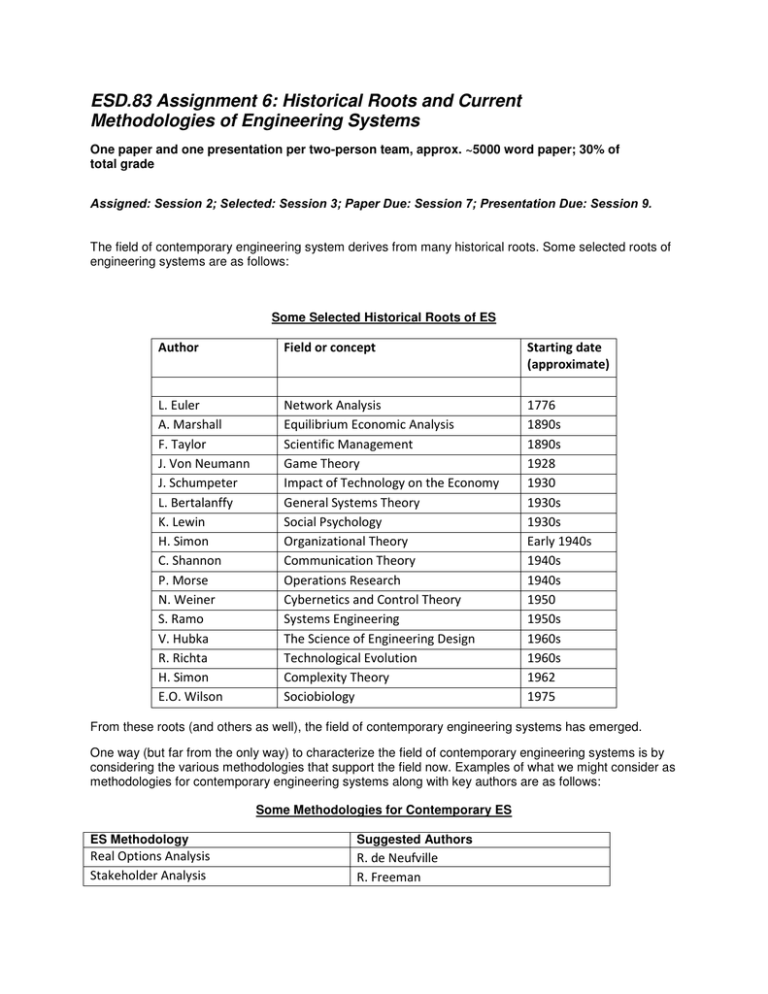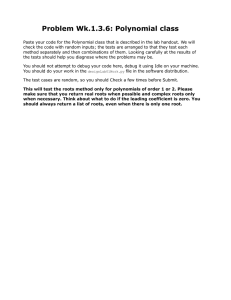ESD.83 Assignment 6: Historical Roots and Current Methodologies of Engineering Systems
advertisement

ESD.83 Assignment 6: Historical Roots and Current Methodologies of Engineering Systems One paper and one presentation per two-person team, approx. ~5000 word paper; 30% of total grade Assigned: Session 2; Selected: Session 3; Paper Due: Session 7; Presentation Due: Session 9. The field of contemporary engineering system derives from many historical roots. Some selected roots of engineering systems are as follows: Some Selected Historical Roots of ES Author Field or concept Starting date (approximate) L. Euler A. Marshall F. Taylor J. Von Neumann J. Schumpeter L. Bertalanffy K. Lewin H. Simon C. Shannon P. Morse N. Weiner S. Ramo V. Hubka R. Richta H. Simon E.O. Wilson Network Analysis Equilibrium Economic Analysis Scientific Management Game Theory Impact of Technology on the Economy General Systems Theory Social Psychology Organizational Theory Communication Theory Operations Research Cybernetics and Control Theory Systems Engineering The Science of Engineering Design Technological Evolution Complexity Theory Sociobiology 1776 1890s 1890s 1928 1930 1930s 1930s Early 1940s 1940s 1940s 1950 1950s 1960s 1960s 1962 1975 From these roots (and others as well), the field of contemporary engineering systems has emerged. One way (but far from the only way) to characterize the field of contemporary engineering systems is by considering the various methodologies that support the field now. Examples of what we might consider as methodologies for contemporary engineering systems along with key authors are as follows: Some Methodologies for Contemporary ES ES Methodology Suggested Authors Real Options Analysis Stakeholder Analysis R. de Neufville R. Freeman Strategy Development Grounded Theory Decision Making Under Uncertainty System Architecting Social Networks Modern network analysis Dynamic programming Stochastic optimization OR Network analysis Technological Dynamics H. Mintzburg, M. Porter B. Glaser, A. Strauss R. Keeney, H. Raiffa E. Rechtin, M. Maier S. Wasserman, K. Faust A. Barabasi, D. Watts, M. Newman D. P. Bertsekas J. Schneider, S. Kirkpatrick, J.C. Spall R. Ahuja, T. Magnanti and J. Orlin J. Utterback, C. Magee, J. Trancik We note that similar terms appear in both the list of historical roots and methodologies of contemporary engineering system, reflecting the evolution of these concepts. In many cases, the approaches changed over time so today’s methodology is quite different from a similarly termed root. This relationship between historical roots and current engineering systems methodologies can be approached in one of two possible ways and is illustrated in the figure below. The first approach is to choose one of the possible historical roots noted above (or perhaps an additional one you would like to suggest) and trace it forward to indicate its impact on the field of contemporary engineering systems as characterized by the methodologies, also noted above. So you want to identify scholarly work that built upon the root, tracing it through to today’s foundation methodologies. Some of the roots may impact several of the contemporary methodologies. There is an alternative way to think about the relationship between past intellectual developments and the field of contemporary engineering systems. This involves “backcasting” from where we are today to the roots. In this construction, one chooses one of the methodologies of contemporary engineering systems and works backwards in time to ascertain from whence it came. Again, a methodology as used today may derive from several of the roots. We have defined each methodology as currently used by noting the work of key authors on that methodology. Again, you could suggest additional current methods or authors. For this assignment, we ask you to work in pairs, which we have specified, to create diversity in interests. Each pair will select one historical root and one contemporary Engineering Systems methodology as currently practiced. We suggest (but don’t require) that you choose a root and methodology that you presume are related such that the root will be one you believe a priori affects your current methodology. The instructing staff will approve your root/method pair, and we will let you know this via email. Remember you are invited to propose other historical roots or current methodologies. It will be interesting to contrast what we learn from the two approaches—e.g., if a root-based analysis shows impact on a methodology, did the methodology-based analysis trace back to that root? This assignment should involve careful historical research of the literature and result in a single jointly submitted paper that describes both the flow from historical root to current methodologies, and the flow from current methodology to historical roots. The paper should be about 5000 words, not including tables and figures you may use to illustrate the interconnections in the literature. (Remember, visual thinking can be powerful.) It is envisioned that the references should be extensive (30-40 or more might be typical). Some approaches you should include in your paper: • Contributors not listed in the historical roots table and contemporaneous scholarly responses to the work of the author we cite • Citation analysis to estimate the influence of various works as paths between roots and methodologies are developed • Influences on practice and research in various domains/contexts that are clear today Some useful resources In many cases, Wikipedia may provide an excellent starting point (www.wikipedia.org). From there you may be able to identify the major works which you may then build from in more rigorous and in-depth library research. MIT OpenCourseWare http://ocw.mit.edu ESD.83 Doctoral Seminar in Engineering Systems Fall 2011 For information about citing these materials or our Terms of Use, visit: http://ocw.mit.edu/terms.





